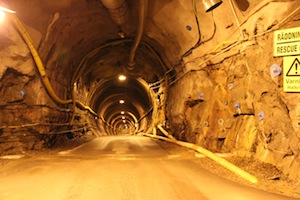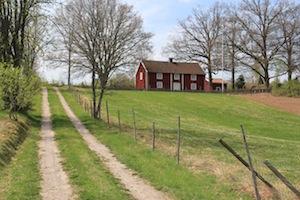…where they actually can get a repository built for “high-level” nuclear waste (they think)

This summer, Climate Watch will launch a three-part radio series on the nuclear waste dilemma. As part of the reporting for that series, The California Report’s senior producer, Ingrid Becker, traveled to Sweden to examine a program touted as a potential model for the world. This dispatch is the second part of her series preview.
The road to Äspö from Gothenburg, where I arrived from San Francisco, winds through a storybook landscape of small farms, lush forests and brick-red houses. Road signs warning of moose crossings pop up at regular intervals along the highways and back roads.

And so it was a bit jarring to later find myself in a granite cavern, standing face-to-face with giant copper tubes, enormous machinery and a specially designed fuel transport vehicle quaintly named after one of the Viking gods.
The trip, 340 meters (1,115 feet) below ground to the demonstration tunnel takes a full minute in a noisy and slightly bumpy elevator. Before we enter the tunnel, I must strap on a transponder, a safety precaution in case of emergency. At this point I’m asking myself if I should be alarmed, but the attentive public relations officer assures me that since the facility opened in 1995, about 10,000 visitors a year have made this trek.
Down in the tunnel, it’s anything but scary. While the lab is not quite an industrial Disneyland, there is an element of showmanship here. The company prides itself on openness and bright graphics detail the plans for storing the waste. Visitors are encouraged to touch the models and sample the salty groundwater flowing through the bedrock. During my visit we are joined by a clutch of students from a local university and researchers from the Swedish defense agency.

The waste won’t actually be stored in these tunnels. This is what SKB calls a “dress rehearsal.” SKB has selected a site further east at Forsmark in the community of Östhammar for the permanent repository. It will take several years for the government to review the 7,000-page application for the repository. Under best-case scenarios, construction could start in 2015. The first canisters wouldn’t actually be buried until 2025.
As with anything requiring this level of scrutiny, there are sure to be a lot more questions about whether the plan is really safe. Before touring the lab, I met with the environmental organization dedicated to watching over the nuclear waste planning process.

MKG director Johan Swahn says six years ago when he began his watchdog role, the repository plan seemed more assured. Today, he has his doubts.
The Swedish nuclear waste company is adamant that its method will be safe, but Swahn says more concerns are being raised about whether the copper canisters could in fact corrode and leak. “Copper is not all immune in those environments,” he says. “The whole idea in Sweden that the industry itself is solely responsible for taking care of the waste (means that) there’s no other funding for research outside industry — and that has led to a situation where we may have fooled ourselves properly.”
As Ingrid Becker continues her research in Sweden, Climate Watch senior editor Craig Miller is touring the only functioning geologic repository for nuclear waste in the US. The two will combine their reporting for the upcoming series.
One thought on “Going Underground in Sweden”
Comments are closed.


Who is doing the planning for the planet here???? How close is the nuclear waste storage in Sweden to the world seed bank storage in Norway????? I note the Swedish plant director has doubts. Is anyone listening. Or, trying to prevent pollution problems BEFORE they happen. Every industry has left a trail of trash from Alaska to Amazon to the AIR…. take note coal, nuclear and oil industries. There must be another way.